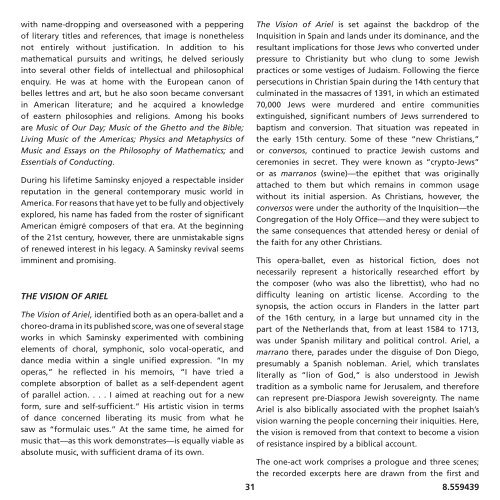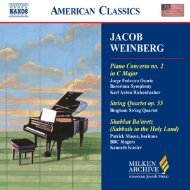Download Liner Notes PDF - Milken Archive of Jewish Music
Download Liner Notes PDF - Milken Archive of Jewish Music
Download Liner Notes PDF - Milken Archive of Jewish Music
You also want an ePaper? Increase the reach of your titles
YUMPU automatically turns print PDFs into web optimized ePapers that Google loves.
with name-dropping and overseasoned with a peppering<strong>of</strong> literary titles and references, that image is nonethelessnot entirely without justification. In addition to hismathematical pursuits and writings, he delved seriouslyinto several other fields <strong>of</strong> intellectual and philosophicalenquiry. He was at home with the European canon <strong>of</strong>belles lettres and art, but he also soon became conversantin American literature; and he acquired a knowledge<strong>of</strong> eastern philosophies and religions. Among his booksare <strong>Music</strong> <strong>of</strong> Our Day; <strong>Music</strong> <strong>of</strong> the Ghetto and the Bible;Living <strong>Music</strong> <strong>of</strong> the Americas; Physics and Metaphysics <strong>of</strong><strong>Music</strong> and Essays on the Philosophy <strong>of</strong> Mathematics; andEssentials <strong>of</strong> Conducting.During his lifetime Saminsky enjoyed a respectable insiderreputation in the general contemporary music world inAmerica. For reasons that have yet to be fully and objectivelyexplored, his name has faded from the roster <strong>of</strong> significantAmerican émigré composers <strong>of</strong> that era. At the beginning<strong>of</strong> the 21st century, however, there are unmistakable signs<strong>of</strong> renewed interest in his legacy. A Saminsky revival seemsimminent and promising.THE VISION OF ARIELThe Vision <strong>of</strong> Ariel, identified both as an opera-ballet and achoreo-drama in its published score, was one <strong>of</strong> several stageworks in which Saminsky experimented with combiningelements <strong>of</strong> choral, symphonic, solo vocal-operatic, anddance media within a single unified expression. “In myoperas,” he reflected in his memoirs, “I have tried acomplete absorption <strong>of</strong> ballet as a self-dependent agent<strong>of</strong> parallel action. . . . I aimed at reaching out for a newform, sure and self-sufficient.” His artistic vision in terms<strong>of</strong> dance concerned liberating its music from what hesaw as “formulaic uses.” At the same time, he aimed formusic that—as this work demonstrates—is equally viable asabsolute music, with sufficient drama <strong>of</strong> its own.The Vision <strong>of</strong> Ariel is set against the backdrop <strong>of</strong> theInquisition in Spain and lands under its dominance, and theresultant implications for those Jews who converted underpressure to Christianity but who clung to some <strong>Jewish</strong>practices or some vestiges <strong>of</strong> Judaism. Following the fiercepersecutions in Christian Spain during the 14th century thatculminated in the massacres <strong>of</strong> 1391, in which an estimated70,000 Jews were murdered and entire communitiesextinguished, significant numbers <strong>of</strong> Jews surrendered tobaptism and conversion. That situation was repeated inthe early 15th century. Some <strong>of</strong> these “new Christians,”or conversos, continued to practice <strong>Jewish</strong> customs andceremonies in secret. They were known as “crypto-Jews”or as marranos (swine)—the epithet that was originallyattached to them but which remains in common usagewithout its initial aspersion. As Christians, however, theconversos were under the authority <strong>of</strong> the Inquisition—theCongregation <strong>of</strong> the Holy Office—and they were subject tothe same consequences that attended heresy or denial <strong>of</strong>the faith for any other Christians.This opera-ballet, even as historical fiction, does notnecessarily represent a historically researched effort bythe composer (who was also the librettist), who had nodifficulty leaning on artistic license. According to thesynopsis, the action occurs in Flanders in the latter part<strong>of</strong> the 16th century, in a large but unnamed city in thepart <strong>of</strong> the Netherlands that, from at least 1584 to 1713,was under Spanish military and political control. Ariel, amarrano there, parades under the disguise <strong>of</strong> Don Diego,presumably a Spanish nobleman. Ariel, which translatesliterally as “lion <strong>of</strong> God,” is also understood in <strong>Jewish</strong>tradition as a symbolic name for Jerusalem, and thereforecan represent pre-Diaspora <strong>Jewish</strong> sovereignty. The nameAriel is also biblically associated with the prophet Isaiah’svision warning the people concerning their iniquities. Here,the vision is removed from that context to become a vision<strong>of</strong> resistance inspired by a biblical account.The one-act work comprises a prologue and three scenes;the recorded excerpts here are drawn from the first and31 8.559439
















